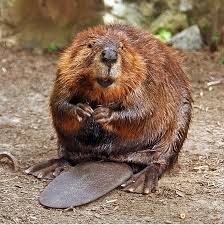We built the American Empire
 No time to play there’s work to do
No time to play there’s work to do
Dams to build, logs to chew
Aspen wood tastes good you know
Tree comin’ down, look out below!
~ Banana Slug String Band, “I’m Proud to Be a Beaver”
Just as the Romans built their empire, we built ours. And who are we? We’re the beavers, of course. Well, I’m “Beaver” anyhow. My friends were “Moose,” “Elk,” “Horse,” Mouse and “Rat.” And that only covered the southwest section of my hometown in Minnesota. I had a friend named “Mule” (Actually, his full moniker was “Francis the Talking Mule,” and he lived in the southeast quadrant, which meant we were rivals when it came to sports.).
As kids, we figured we needed to be identified by animal names that somehow fit us as individuals. Little did I know that millions of beavers, in crossing the Bering Land Bridge, would be the first to shape North America and decidedly pre-date its human history. Was I being labeled as a descendent of these animal nomads? Sort of, perhaps. My friends chose “Beaver” because I always had a “Beaver story” after coming back from our summer camp on Isle Royale in Lake Superior. If not “Beaver” I easily could have been “Loon.” They were also plentiful, and the two animals were, in many ways, dependent on each other. The beavers dammed a pond near our camp on which a loon pair lived and fed. But when the beavers decided to move on, their dam disintegrated and the pond lost enough water to strand the loons until the park rangers could net them and deposit them in the open lake.
Wired magazine last December contained an article titled “Follow the Beaver: Trappers, Media Theory, and Our Warming Planet” that was taken from a study showing that pre-Columbian tribes had followed beavers to North America and built cultures around “beaver dams . . . harvested their meat, fur and glands, including the musky secretion of the castor anal sac, which is still used in perfume.”
So, believe it or not, we might not be here as North Americans had it not been for my beaver relatives—and they should be noted for their exploratory incentives. They were curious immigrants, not frightened ones.
We decedents, in turn, should look back with pride, recognizing that it was other than human migration that made North America a place where humanity was able to bring itself into existence. It was due, in many regards, to these engineers of the animal world. They maintained their existence through their constructive instincts. They built dams that created a natural world from which they could gain food and homes in which they hibernated through freezing winters.
According to the research, one part of that foundation came many centuries after their migration and, in fact, rested on top of man rather than in his stomach. This was the “beaver-skin hat.” Apparently, as a result of the hat’s vast popularity, beavers almost went extinct giving up their skins for chapeaus. My mother was convinced that we should bring a pelt back out of our National Park and over two international borders. She had done that before with young birch trees. Why not animal pelts?
The beaver trappers chased their prey northward onto the Precambrian shield that runs from Michigan to Greenland. These trappers meant to weaken tribal bonds so they could profit from beaver pelt sales to corporate enterprises such as Hudson’s Bay Company.
The authors tie beaver migration to climate change, saying we may “soon follow the beavers and push north again, seeking not pelts but asylum from extreme heat and drought.” The beavers did beat us there, so, again, we would not be the trailblazers. My beaver relatives, “ever adaptable and enterprising, got to the tundra first.”
You don’t suppose they could look into the future, do you? Are there other galaxies for these creatures? Heavens to beavers, maybe so.
Now I don’t mean to demean my other animal friends. We grew up as a tribe. They each had their place in our culture, and they certainly were looked upon as people whose mannerisms matched their animal nicknames. “Mouse” was the smallest of our group. “Moose” was solid and a very good football player. “Horse” was fast. And “Elk” enjoyed the stateliness of his species. I think there was even a “Squirrel” who loved to climb trees and eat nuts.
Some things never leave the planet, however. Nearly 40 years after heading east from Minnesota, I came back to visit my parents in their new assisted-living quarters. I happened to poke my head into the manager’s office, and he looked up to greet me. “Hey, Beaver. How are you? It’s been a while.”
Aah, nicknames never die.

